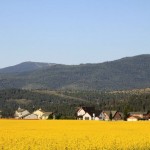by Catherine Haug, August 1, 2012
A few weeks ago, canola fields were in bloom all around the Flathead valley. You will recognize them by their bright yellow blooms as in the photo by Devvi Morgan, right.
But despite their sunny look, their disposition is not so sunny. Most, if not all, of these crops are Roundup-Ready® Canola (1), a GMO crop. This means that even IF the GMO aspect were harmless (which I don’t believe is the case), these crops are heavily sprayed with Roundup to control weeds. They may also be heavily sprayed with insecticides. These sprays are then present in the air we breathe and get into the groundwater, and can contaminate our drinking water.
Did you know that canola seeds spread rapidly and cross-pollinate with many other brassicas including turnips, broccoli raab, some kales, rutabaga, and possibly radish and broccoli, according to research at Oregon State University? This means that if you have any of these growing in your garden, their seeds could be contaminated with GMO DNA from the canola. If you are a seed saver, you may not want to save these.
Apart from the GMO aspect, canola poses other health risks.
Canola (short for Canada Oil Low Acid) is a hybrid version of the rapeseed plant, a member of the cabbage family. But unlike its cousins (cabbage, broccoli, turnips & mustard), rapeseed is toxic, containing significant amounts of erucic acid. (The primary toxic effects of erucic acid involves the heart and myocardial tissue).
Canola was developed to have significantly lower levels of the toxic erucic acid than the parent rapeseed plant. Its intended use was as livestock feed. It has since been widely used as a cooking oil, and in salad dressings.
While the original canola hybrid was created by genetic breeding, the majority of the canola crops grown today are the result of genetic engineering (GE or GMO), not only to introduce the Roundup-Ready aspect but also to further reduce the levels of erucic acid in the oil.
Health food claims
Canola oil is being marketed as a healthful food; many national chain restaurants such as McDonalds, advertise the use of canola oil in their deep fat friers and in their salad dressings. Health-food brands of salad dressings tout their use of canola oil. It should be noted that many of these brands use GMO canola oil. And it is a common ingredient in ‘healthy’ butter alternatives (margarine, etc.).
In my opinion, we would be wise to minimize the use of canola oil in general, and avoid all use of GMO canola oil. The best way to avoid the GMO is to buy products that are at least 85% Organic. (It should be noted that many so-called health-food brands are NOT Organic).
Not high-heat tolerant
Most seed oils, including corn, safflower, cottonseed and canola, are NOT heat tolerant. They are readily oxidized upon heating, producing free-radicals that are very damaging to health at the cellular level.
These oils should never be used for deep-fat frying and other high-heat cooking methods, because of the oxidation/free-radical issue.
They can be used in salad dressings and condiments like mayonnaise, but only if they are cold-pressed. Most seed oils are extracted using high heat and pressure, which, like high-heat cooking, oxidizes the oils and produces free radicals. Cold-press processing produces far fewer free radicals.
Alternatives to canola oil
I personally favor the use of olive oil in my salad dressings, not only for the flavor, but also for its healthfulness. And I don’t use any seed oils for frying, favoring a mix of lard (that I render myself to avoid the hydrogenated commercial lard) and coconut oil. For baked products, I use butter, coconut oil and lard.
Sources
- Daily InterLake: Canola taking root in the Flathead, by Lynnette Hintze
- Handbook of Food Technology

[…] In the film, a strong point is made about the rampant contamination of seeds with GMO genetic material. Not even Certified Organic is safe. And remember that some species, like members of the cabbage family, easily cross-pollinate. This means that seeds from mustard, kale and other brassicas you grow in your garden, could be GMO-contaminated, since canola is a popular crop in the Flathead Valley. The only way to know if the seed is contaminated involves killing the seed to examine its cells. See my earlier post: GMO Canola in the Flathead. […]
There are a host of modern diseases that we have been FORCED to endure as a DIRECT result of the pesticide laden foods and the GMO crops that they are sprayed on. GMO’s are a scourge and the whole concept is unnatural.
Diverticulitis and other related diseases are exploding in the Flathead Valley.
Simply do not EVER consume ANY GMO products, do not EVER condone there use or growth and DO NOT support, associate with or do business with those who grow GMOs.
Thank You.
Jay,
Thank you for your comment about GMOs. Essential Stuff Project (ESP) is a voice in the Bigfork community that speaks out against GMOs and the poisons that are applied to GMO crops. Right now, canola is coming back into bloom and it makes me angry all over again.
The challenge is educating others about which foods likely contain GMO ingredients. Many people want to avoid GMOs but don’t know how. For example, cornmeal; if it doesn’t say Organic on the label, it likely is GMO. But if the label is Bob’s Red Mill, a reputable company, people assume it is GMO-free, even though it doesn’t say Organic. I avoid that particular product because it doesn’t say ‘GMO-free’ or ‘Organic’ on the label.
If you have any ideas on how to help people know which foods are likely GMO, please send them my way and I’ll post them on our website. Also, if you want to read other articles on GMO, check out this link: GMO Articles (this site).
Cat